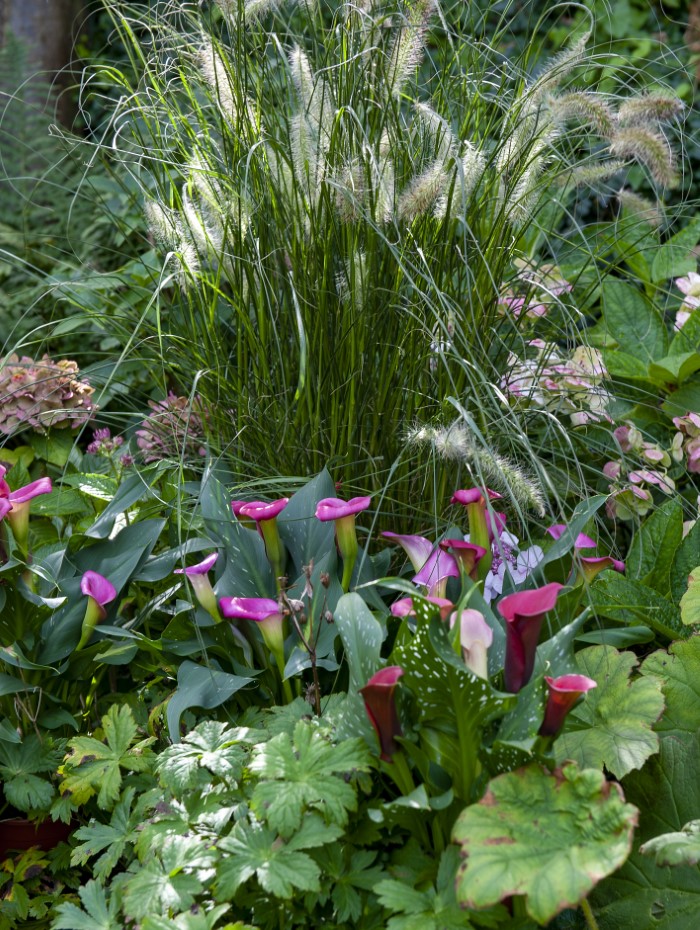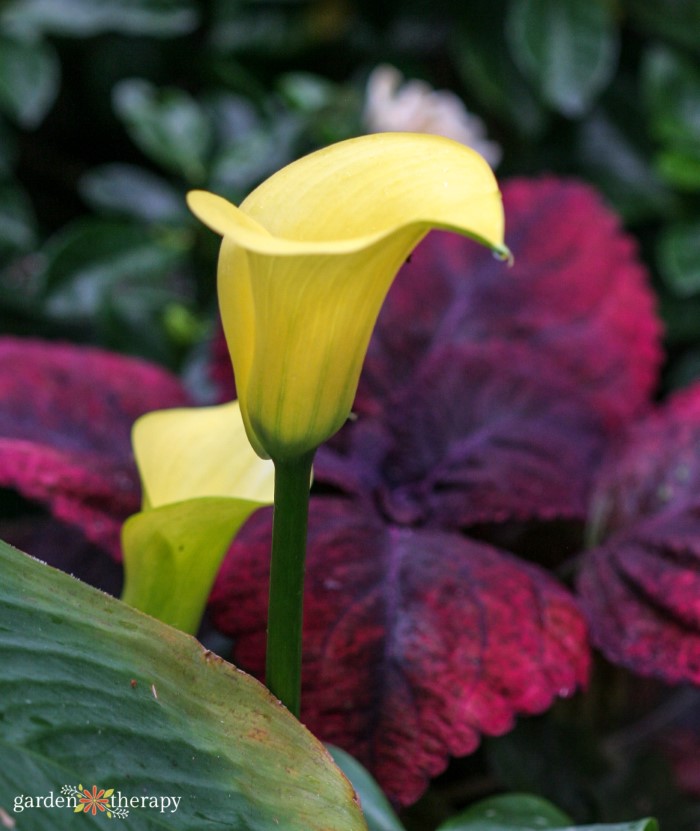Sophisticated and dignified, calla lilies have a certain way about them in the garden. Whether you’re looking to attract hummingbirds or want something unique to feature in your patio plant collection, you won’t be disappointed by the calla lily. Learn how to plant calla lily rhizomes, care for them, and even propagate and overwinter them for next season!

Calla lilies are one of those unique-looking plants you can’t help but marvel at. Their flower stalks of a single seamless petal rise above bright and tropical-looking foliage to catch your eye.
I love looking at calla lilies after a rainfall. Their chalice-like flowers fill with water and you can even find small wildlife stopping for a drink from the flowers.
Extremely elegant, they’re a versatile flower that works well in landscapes, containers, and even as a houseplant. You would think such a marvellous flower would be hard to grow! Luckily, it doesn’t take much work for even the beginner gardener to grow calla lilies. Let me explain!
This post will cover...
- Meet the Calla Lily Flower!
- How to Plant Calla Lilies
- Container Planting
- Calla Lily Care
- Sunlight Requirements
- Soil Needs
- Watering
- Fertilizer
- Pests and Diseases
- Deadheading
- Calla Lily Care Indoors
- Overwintering Calla Lilies
- Propagating Calla Lily Flowers
- Frequently Asked Questions About Calla Lilies
- More Flower Growing Guides

Meet the Calla Lily Flower!
Originally from southern Africa, calla lilies belong to the Zantedeschia genus which includes eight species. Despite their name, calla lilies are not a true lily and grow from rhizomes rather than bulbs or tubers.
Calla lilies come in a trumpet-like shape resembling a spathe and a spadix. A modified leaf, most mistake the spathe for the flower as it looks like one seamless petal. Inside you’ll find the spadix which is the true flowering part of the plant. Extremely long-lasting flowers, they bloom from early to midsummer.

The most common colour you’ll find calla lilies in is white (a bridal bouquet favourite!). However, you can find them in nearly any colour including yellow, orange, red, rose, pink, burgundy, deep purple, all the way to almost black.
The leaves themselves are a spectacle all on their own. Oftentimes you’ll find the leaves covered with white speckles. Leaf colours range from jade green to sage, and are shiny with a swordlike tip.
Unsurprisingly, the name itself speaks to its splendor. The calla lily meaning comes from the Greek word for beauty, kallos. The flower represents amazing beauty and also expresses love and fertility.

How to Plant Calla Lilies
Calla lilies are winter hardy in zones 9-11. Other regions can grow the plant as an annual, which tends to be the more popular route! Plant your calla lilies in spring after the risk of frost has passed. If you want to get a jump start, you can also plant them a month before the last frost date.
When selecting the rhizomes, look for healthy, large ones with at least one eye (the growing points of the rhizome). The more eyes and the bigger the rhizome, the more flowers you’re going to get!

Prepare your soil by mixing in some compost before planting. This will improve drainage and boost the nutrients in the soil. Plant the rhizomes no more than 4” deep and 12” apart with the eyes facing upwards. Barely cover the tops with soil.
Water the rhizomes after planting making sure to soak the soil so it settles around the tubers. After 2-3 weeks, you should see shoots appear. Afterward, the plant will grow quite quickly.
If you are growing your calla lilies as a perennial and live in a warmer region, the roots and tops will begin to form in the fall. However, you’ll still get the flower in spring or summer.

Container Planting
Like most summer bulbs, calla lilies do exceptionally well when planted in containers. When looking for a container, make sure it’s at least 16 inches or larger. It should be large enough to house the fully mature plant and have drainage holes.
Use a good quality potting mix and add in some compost before planting your bulbs. In containers, you can plant the calla lily rhizomes closer together, about 4-6 inches apart.

Calla Lily Care
Once they’re planted, the work is pretty well done! However, here are some extra care tips to ensure you get plenty of blooms from your calla lily.
Sunlight Requirements
Calla lilies tend to like filtered light or partial shade. If you live in a region with temperate summers, then plant them in full sun. Otherwise, anywhere with hot summers should plant calla lilies in partial shade. Full sun can burn the leaves!

Soil Needs
Calla lilies prefer rich, well-drained, and slightly acidic soil. You can add soil amendments to improve the soil and provide better drainage.
While they do not like soggy soil, they do well on the edges of bogs, ponds, or streams just fine. As long as the roots aren’t sitting in constant water, they’re okay!
Watering
Calla lilies need watering during their active growth period. As a rule of thumb, they need 1” of water a week, whether that comes from rainfall or the garden hose.
During extremely hot temperatures, you may need to water the calla lilies every other day. Calla lilies planted in containers will also require more frequent waterings.

Fertilizer
Calla lilies planted in the ground won’t require fertilizer as that initial compost will keep them well fed for the summer.
In containers, you will want to give calla lilies a boost of liquid fertilizer every couple of weeks. Callas are heavy feeders and this will help them produce plenty of blooms. Only fertilize when the plant is growing and flowering.
Pests and Diseases
You may see aphids collect and feed on the undersides of the leaves. Give the plant a good blast of water to get rid of the aphids.
Slugs and snails may leave holes in the leaves or eat them entirely. Simply pick them off to get rid of them.
Other pests include whiteflies and spider mites. Make a natural pest control spray using herbs from your garden if they become an issue.
In warm or humid conditions, the plant may also develop powdery mildew. A fuzzy white or grey fungal disease, better air circulation is the best way to prevent it.

Deadheading
To encourage more flowers and conserve energy for the rest of the plant, deadhead them. Simply remove any spent flowers with a pair of clean scissors or shears.
You can also safely cut fresh flowers from the plant to bring indoors. Calla lilies are very popular with florists as they’re such great cutting flowers.
Once the plant is done blooming, make sure to leave the foliage in place. It works hard to gather energy for the rhizomes for next season’s growth.

Calla Lily Care Indoors
Calla lilies can also be grown as indoor plants and you’ll often find them for sale as gifts. Care for calla lilies inside is relatively similar to those planted outdoors.
Place the calla lily in bright, indirect light away from any heating or cooling vents. Make sure the container has drainage holes and keep the soil moist but never soggy.
Indoor calla lilies will also go into dormancy and you can then reduce your waterings. Move the plant to rest in a cool dark area. Dormancy often begins in November. Whenever the foliage or flower dies, cut the leaves to the soil level.
In the spring when the plant begins to grow again, begin fertilizing every couple of weeks throughout the entire growing season. Stop fertilizing during dormancy.

Overwintering Calla Lilies
In the fall once all the foliage is brown, it’s time to store your calla lilies for the season. The foliage should easily pull away from the roots before you attempt to remove the plant. Wear gloves while handling callas to protect your skin from potentially irritating compounds.
Use a garden fork to carefully loosen the soil around the clump. Once removed, gently brush away any dirt and trim any dangling roots. Cut remaining foliage to 2-3 inches tall.
Wrap the rhizomes in newspaper and a growing medium like coconut coir or vermiculite. Alternatively, you can layer them in a box or paper bag. Check them every once and a while and give them a light spritz of water. Throw out any rhizomes with signs of rot.
Let the rhizomes rest for a few months after flowering has finished before you plant them again and start the next growth cycle.
If you live in a warm climate where the rhizomes are hardy, leave the rhizomes in the ground. Add a layer of mulch atop the tubers to protect them.

Propagating Calla Lily Flowers
While they can be grown from seed, the best way to propagate calla lilies is through rhizome division. Calla lilies decrease flower production when they get overcrowded, so be sure to divide the plant every 3-5 years.
Using a sterilized garden knife, carefully cut rhizomes into new sections. Make sure each section has at least 1 eye but aim for 3.
Let the new division dry out for 1-2 days before you replant them or wrap them up for storage.

Frequently Asked Questions About Calla Lilies
Calla lilies are considered tender perennials. They’re winter hardy in zones 8-11. In other regions, they’re typically grown as annuals. You can also dig up and save the rhizomes to overwinter them for the next season.
Calla lilies contain insoluble calcium oxalate crystals. If they are ingested by humans or pets, they can cause a burning sensation and swelling among the lips, throat, and tongue, and cause upset stomachs. Be sure to plant calla lilies well away from areas with pets and small children.
You can grow calla lilies indoors or outdoors. Outdoors, they’re most typically grown as annuals in beds and containers. You can overwinter the rhizomes inside to grow again the following season. Inside, they look like a tropical houseplants that will provide the same trumpet-like blooms.
In areas with temperate summers, place your calla lilies in direct sun. Otherwise, calla lilies prefer partial or dappled shade.

Enjoy your calla lilies! They truly are elegant flowers that stand out even amongst the most colourful and ornate gardens. Leave any more of your calla-growing questions in the comments down below.




